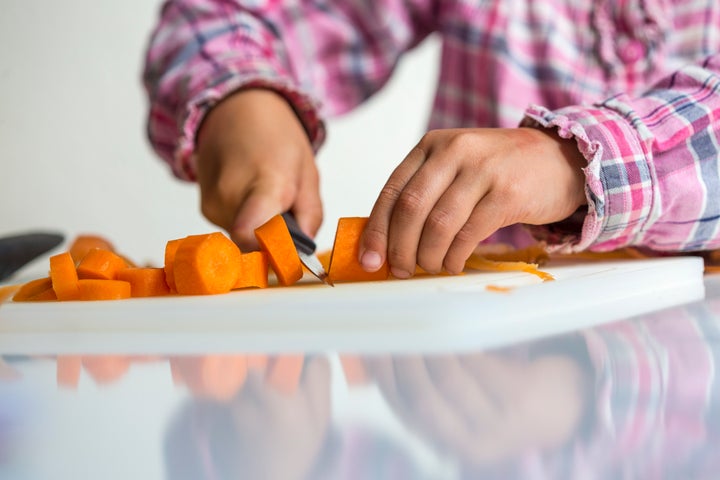For many families, the kitchen serves as a central location for catching up with loved ones and building lasting bonds between parents and their kids. If your kids show a keen interest in food (or, at least, in enjoying their favorite meals and snacks), getting them involved in the cooking process from an early age can create culinary habits that serve them for the rest of their lives.
If you’re wondering how to put your kids to work in the kitchen at any age, we have a comprehensive guide to cooking tasks that best suit children at different phases of development, starting at age 2 and going up to age 17.
Ages 2-4: Putting ingredients in bowls and mixing
The toddler years are essential ones for forming relationships with food and for developing personal preferences. “Getting kids in the kitchen at a young age (2-4) can help kids develop life skills and reduce picky eating habits,” explains Amber Rodenas, a registered pediatric dietitian and owner of Seeds and Sprouts Nutrition. “These ages are particularly crucial in development of food preferences and gaining autonomy. Picky eating typically presents itself at these ages.”
In terms of kitchen tasks that can be delegated to very young kids, Rodenas urges you to pick jobs that encourage “motor development and also help kids use their sense of touch, smell and taste to expose themselves to many foods, which reduces picky eating.”
For example, asking your 2- to 4-year-old to pour pre-measured flour into a mixing bowl gives the child a chance to touch the flour, see how it falls into the bowl, and form an understanding of that ingredient on a visual and tactile level. For slightly older toddlers, taking a rubber scraper in hand and stirring a batter or a fruit salad (while Mom or Dad holds on to the bowl) allows them to feel useful, since they can clearly see how their work leads to a more complete meal.
Ages 4-7: Helping with table-setting and cleanup
Really hate kitchen and table cleanup? We have some good news for you: These tidying tasks can be ideal kitchen-helper assignments for kindergarteners and young elementary students.
“Since my children entered kindergarten (age 5), they have been required to clear the table after dinner, putting all the dishes and silverware into the sink,” said licensed psychologist Jessica Biren Caverly of Western Connecticut Behavioral Health. “At age 6, they started rinsing the dishes before putting them into the sink. At age 7, they started putting the dirty dishes into the dishwasher.”

Paco Navarro via Getty Images
Michele Schwartz, a pediatric occupational therapist and the founder of The Virtual Pediatric OT, tells us these organizational jobs are easy for children to wrap their brains around, and they’re also well within their motor-skills capabilities.
For instance, “setting the table improves cognitive skills such as matching, multistep directions and right/left discrimination,” Schwartz said. As long as you give the child clear instructions at this age, asking them to help put silverware on the table and to drop said silverware in the sink or dishwasher after the meal will keep your little ones busy while you cook and clean.
Ages 5-8: Figuring out recipe steps and their order
By the time kids reach elementary-school age, they have the cognitive abilities to follow a list of chronological instructions. That’s why pediatric neuropsychologist and author Sarah Allen believes these children can execute recipe steps when delivered verbally and can understand the order of steps on their own.
“The best way to promote brain growth while cooking is to model the cognitive processes out loud. Which comes first, the eggs or the flour? When do I set the oven? What would happen if I set the oven after I mixed the cookies? These reflective questions require your child’s brain to make the neuronal connections necessary to sequence and problem-solve,” Allen explained.
While you’ll want to pose these questions to younger children and also provide them with the answers, Allen said elementary-school-aged kids can “begin to answer these questions with less and less input from their parent. You can even play a fun game of ‘what comes first?’ Play with the sequence (e.g., ‘Would you put the chocolate chips in first, and then the eggs?’). The sillier, the better! The more emotion you create, the better the learning.”
Ages 8-10: Adjusting recipe quantities
“If I had to pick a favorite growth activity involving cooking, it would [happen at] the age of 8-10 years,” Allen told us. According to her, late elementary-school kids can use the skills developed in math class to double a recipe. “This requires an understanding of fractions (multiplication or addition, depending on the age and math level), mental manipulation and problem-solving (hello, frontal lobe development!), and an understanding that adding fractions together equals more (e.g., 1/2 plus 1/2 has to be a bigger cup),” Allen said. “This is truly a multisensory experience with excellent visuals!”

Westend61 via Getty Images
Ages 9-12: Working with more ‘dangerous’ kitchen tools and appliances (with supervision)
Children in their pre-adolescence have more sophisticated motor skills than their younger counterparts. For that reason, kids from ages 9 to 12 can take on greater responsibility in the meal prep process, even when those responsibilities involve tools with blades and high temperatures.
Starting in the early years of this age range, kids can “use can openers and pizza cutters [and can] stir and mix over heat,” said childhood speech language pathologist Kjirsten Broughton of Southern Nevada Speech and Language Services. Of course, for safety’s sake, these assignments should be fulfilled when an adult can be present to supervise.
Ages 13-15: Following more complex recipes and taking initiative in the kitchen
The onset of puberty signals the start of an exciting new phase for kids in the kitchen. Specifically, teenagers are able to “make their own choices about diet, learn how various foods affect the way they look and feel, and find ways to be more independent,” said licensed clinical psychologist and clinical director Allison Kawa of the Los Angeles Center for Integrated Assessment.
In the early teenage years, kids can make decisions about what they want to eat and how they’d like it prepared, and they can follow written recipes. Therefore, an enthusiastic teenage cook makes a capable sous chef with plenty of opinions about ingredients and meal prep.
Ages 16-17: Independent grocery shopping and meal prep
Many older teenagers are preparing to leave the nest and start living independently, so the kitchen help they provide should be as autonomous as possible.
Clinical mental health counselor and psychotherapist Chudney Drew of Counseling With Intention says that asking your 16- or 17-year-old to design their own menu and to take the lead on grocery shopping and meal prep will “boost self-confidence and give them the opportunity to showcase and share with their families what brings them comfort and joy.” Also, this task can instill “necessary planning and organizational skills that will help them as they navigate through young adulthood.”

